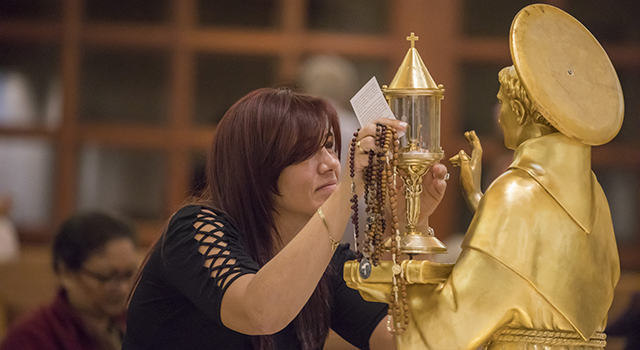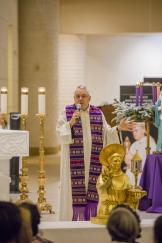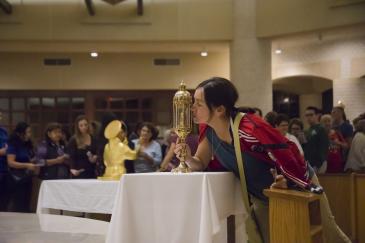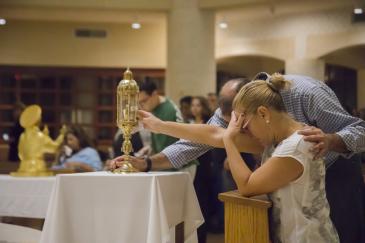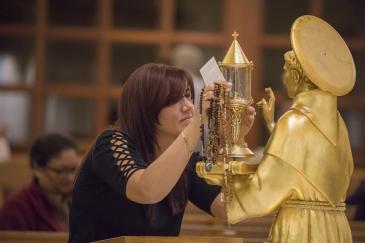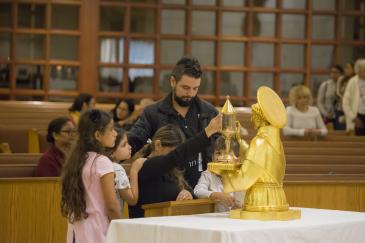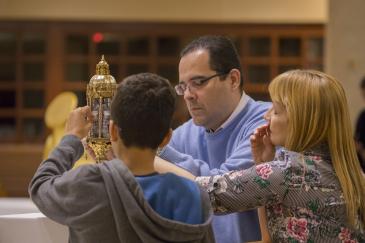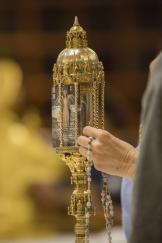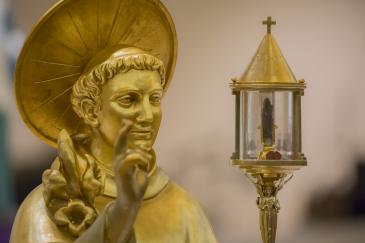By Cynthia Thuma - Florida Catholic
Photography: JONATHAN MARTINEZ | FC
DEERFIELD BEACH | The crowds who showed up at his every appearance came with more enthusiasm than if Fernando Martins de Bulhoes had been a captain of industry, a well-known politician or a rock star.
But with far more respect and reverence, the faithful from throughout the Archdiocese of Miami (and sometimes even beyond) showed up to venerate him by the name he is better known: St. Anthony of Padua, a 13th century Franciscan friar, priest and teacher.
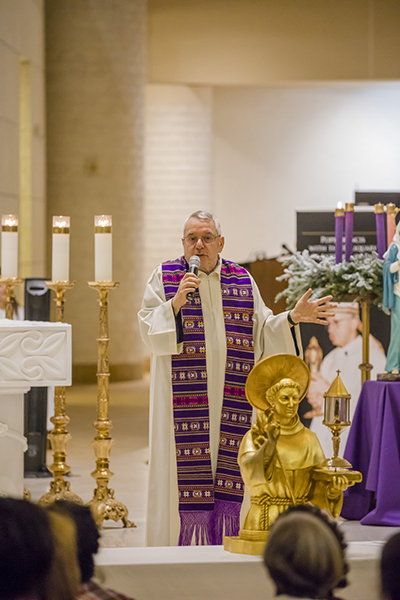
Photographer: JONATHAN MARTINEZ | FC
Father Mario Conte of the Basilica in Padua, Italy, preaches the homily at a Mass coinciding with the veneration of two relics of St. Anthony of Padua. The Mass took place Dec. 3 at St. Mark Church in Southwest Ranches.
Much loved for his works as patron saint of Portugal, the elderly, women unable to bear children and lost and stolen articles, St. Anthony was born into a prosperous family in Lisbon in 1195. In his 36 years on earth, he traveled widely throughout the world spreading the Gospel and died in Padua, Italy in 1231, where he is buried.
Two golden reliquaries from the basilica of Padua toured 13 sites within the archdiocese, from Marathon to Coral Springs from November 30 to December 9. One reliquary bore a small piece of skin from the saint’s cheek; another bore one of his floating ribs.
Father Mario Conte, from the Pontifical Basilica at Padua and editor of the St. Anthony Messenger, accompanied the relics and served as homilist at the Masses. He told those attending Mass that when they approached the altar to venerate the relics to do so with quiet reverence.
“It is a link of love, a connection,” he said. “There will be no sparks, no fireworks, nothing at all, but to know you are touched by the love of God.”
Regarded as a simple, gentle yet profound man, St. Anthony’s message is as simple, direct and loving, Father Conte told the faithful at Our Lady of Health Syro-Malabar Church in Coral Springs. “St. Anthony would like to give you a simple message: God knows everything. You are not the byproduct of the movement of atoms in the universe. You are children of God.”
The occasion was especially meaningful for the parishioners at Our Lady of Health, because it was the first time the Coral Springs church had been selected to host blessed relics since its founding in 1984.
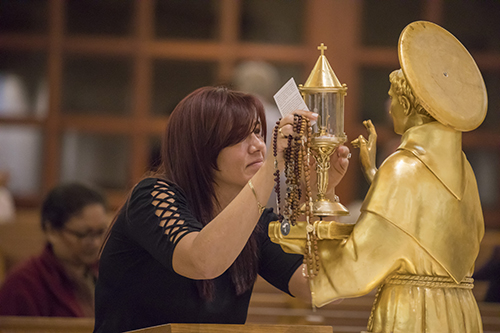
Photographer: JONATHAN MARTINEZ | FC
Eysac Aquino, parishioner at St. Mark Church in Southwest Ranches, prays in front of a relic of St. Anthony of Padua that was venerated at the church Dec. 3. Two relics from the basilica in Padua, Italy, traveled through South Florida churches Nov. 30-Dec. 9.
Mary Kuruvila, of Weston, said she would not have missed the event. Several years earlier, she had been seriously injured in a traffic accident. Her left elbow was mangled and as she lay paralyzed in a hospital bed, she found herself considering St. Anthony and his works. Now completely healed, she came to Mass to venerate the relics and give thanks for her recovery.
“We Indians love him for his apostolate,” she said.
At St. Gregory the Great Parish in Plantation, Yamile Stevenson waited silently in a long line between Masses for the chance to press her prayer card against the glass of the reliquary.
“I’ve been a parishioner here for over 40 years,” Stevenson said. “I pray every day, the typical devotions, but here today, I am praying for my children.”
Mass-goers gently touched the glass of the reliquary, while others removed crucifixes from their necks and gently placed them against the glass. Others were content to simply pray before the reliquaries or whisper to their young children about the significance of what they were doing and why.
The relics have been displayed widely throughout the world over the years and especially so since June. In that time, they have been on display in churches throughout Ohio, New Jersey and Pennsylvania; in the Canadian provinces of Ontario and Nova Scotia and the Australian states of Victoria and South Australia.
What are sacred relics?
- Sacred relics are physical remains of saints and other persons revered for their holiness, such as persons who have been proposed for sainthood who have not yet been canonized along with items which have been “sanctified” by having been worn by or otherwise touched by his or her body.
- Relics are divided into two classes: First class relics include the physical body parts (usually bones), clothing, and instruments connected with a martyr’s imprisonment, torture, and execution. Second class relics come from something the saint owned or used during his life on earth.
- Relics are reminders of the lives and acts of saints and holy martyrs and are not to be worshipped, but rather to be venerated and reflected upon.
- In 2005, Pope Benedict XVI said: “Relics direct us toward God himself: It is he who, by the power of his grace, grants to weak human beings the courage to bear witness to him before the world. By inviting us to venerate the mortal remains of the martyrs and saints, the Church does not forget that, in the end, these are indeed just human bones, but they are bones that belonged to individuals touched by the living power of God. The relics of the saints are traces of that invisible but real presence which sheds light upon the shadows of the world and reveals the Kingdom of Heaven in our midst.”
